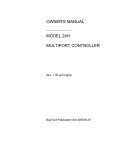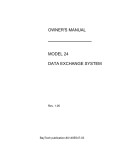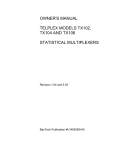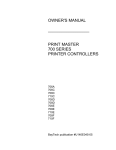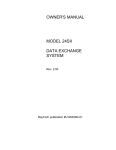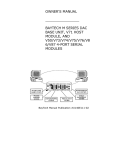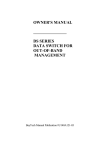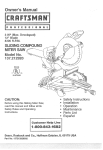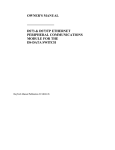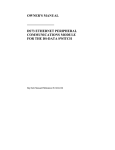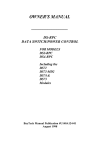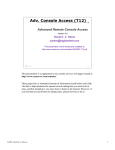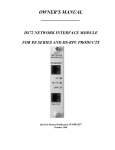Download Bay Technical Associates 5218H Owner`s manual
Transcript
OWNER'S MANUAL H-SERIES MULTIPORT CONTROLLERS 525H 528H 529H 5218H BayTech publication #U140E043-04 Thank you for selecting a BayTech multiport controller. The data provided in this Owner's Manual explains the various ways you can operate your unit and configure it to your own computer system. We suggest that you read this manual carefully before attempting to install your multiport controller and that you place special emphasis on correct cabling and configuration. If you have any problems with your installation, please contact a BayTech applications engineer for assistance. BayTech also manufactures data communications devices that provide buffered and non-buffered peripheral sharing. If you would like information on any of these models, please contact BayTech Sales/Service. We welcome any comments you may have about our multiports. And we hope that you will continue to look to BayTech for your data communications needs. NOTE: The information contained in this document is subject to change without notice. Copyright 1993 by Bay Technical Associates, Inc. IBM PC, IBM PC/AT, IBM PC/XT are products of International Business Machines Corporation. All products or company names are trademarks of their respective holders. TABLE OF CONTENTS 1 GENERAL INFORMATION ........................................................................ 1 2 SPECIFICATIONS ..................................................................................... 4 3 INSTALLATION.......................................................................................... 6 3.1 3.2 3.3 3.4 UNPACKING ................................................................................ UTILITY SOFTWARE DISKETTE ................................................ POWER ........................................................................................ FACTORY DEFAULTS................................................................. 6 6 7 8 4 CABLING.................................................................................................... 9 5 OPERATION ............................................................................................ 11 5.1 USER-PROGRAMMABLE OPERATIONS ................................. 11 5.1.1 5.1.2 5.1.3 5.1.4 5.1.5 5.2 11 12 12 12 13 5.1.5.1 5.1.5.2 5.1.5.3 5.1.5.4 5.1.5.5 5.1.5.6 13 13 14 14 14 15 MODE OF OPERATION 1............................... MODE OF OPERATION 2............................... MODE OF OPERATION 3............................... MODE OF OPERATION 4............................... MODE OF OPERATION 5............................... MODE OF OPERATION 6............................... OPERATING IN THE DIFFERENT MODES............................... 15 5.2.1 5.2.2 5.2.3 5.2.4 5.2.5 5.2.6 5.3 5.4 THE SERIAL PORT CONFIGURATION ....................... THE MESSAGE TERMINATING CHARACTER ........... SET DATA BLOCK LENGTH........................................ THE CONTROL CHARACTER ..................................... THE MODES OF OPERATION..................................... OPERATING IN MODE 1.............................................. OPERATING IN MODE 2.............................................. OPERATING IN MODE 3.............................................. OPERATING IN MODE 4.............................................. OPERATING IN MODE 5.............................................. OPERATING IN MODE 6.............................................. 16 17 18 18 19 19 BINARY MODE........................................................................... 20 BREAK CONDITION .................................................................. 20 5.5 DATA FLOW CONTROL ............................................................ 21 5.5.1 5.5.2 6 CONFIGURATION ................................................................................... 25 6.1 6.2 6.3 6.4 6.5 6.6 6.7 6.8 6.9 7 525H AND 529H ........................................................... 21 528H AND 5218H ......................................................... 23 MAIN CONFIGURATION MENU ................................................ STATUS...................................................................................... SET SERIAL PORT CONFIGURATION ..................................... SET MESSAGE TERMINATE CHARACTER............................. SET DATA BLOCK LENGTH ..................................................... SET CONTROL CHARACTER................................................... SET MODE OF OPERATION ..................................................... EXIT............................................................................................ NON-VERBOSE MODE ............................................................. 25 26 27 29 30 31 32 32 33 MAINTENANCE ....................................................................................... 36 7.1 7.2 RETURNS TO THE FACTORY .................................................. 36 REPACKING FOR SHIPPING.................................................... 36 8 TECHNICAL SUPPORT........................................................................... 37 9 FEDERAL COMMUNICATIONS COMMISSION RADIO FREQUENCY INTERFACE STATEMENT ...................................................................... 38 APPENDIX A TROUBLESHOOTING ............................................................................. 39 APPENDIX B INDEX ...................................................................................................... 44 The BayTech H-Series multiport controllers are flexible, multi-function data acquisition and control units that provide cost effective data communications for applications that require control of multiple peripherals from a single host computer. Designed with flexibility in mind, the H-Series controllers can be programmed to provide full duplex communication between host and peripheral or can provide real-time data acquisition from remote peripherals. In a typical application, the host port may be connected to such devices as bar code readers, cash registers, fire alarms, numerical machines, modems, plotters, printers, security systems, and terminals. The host computer system may individually select up to seventeen peripheral devices and send data to the selected device. The 525H interfaces four peripheral devices to a single host device, the 528H and 529H interface eight peripherals, and the 5218H interfaces seventeen peripherals. All H-Series models will simultaneously multiplex incoming data from peripheral devices to be transmitted to the host system. The method of data transmission from the peripheral devices to the host system is dependent upon the mode of operation. The H-Series models feature six user-selectable modes of operation. The six modes of operation are: Mode 1 Full Duplex Communication - Allows a single host computer to switch between a maximum of seventeen peripheral devices. Provides bidirectional data transfer between the host computer and the selected peripheral device. Data received from non-selected peripheral devices is stored in a buffer until the port is selected. Mode 2 All messages from all ports - Provides automatic multiplexing of all messages from all peripheral devices. Data is buffered until a terminating character is received or until the buffer fills. The messages are then sent to the host device preceded by a port identification code. Mode 3 Single message from all ports - Same as Mode 2, except that a single message from all peripheral devices is sent to the host device upon request. Mode 4 All messages from selected port - Same as Mode 2, but with specific port selection. Mode 5 Single message from selected port - Same as Mode 3, but with specific port selection. Mode 6 Time division multiplexing - Provides automatic multiplexing of data from peripheral devices by continuously scanning all ports to check for characters in the receive buffers. If a receive buffer contains data, it is transmitted through the host port in data blocks with each data block preceded by a port identification code. Transmission continues until the buffer is empty or until a user-specified data block length has been transmitted. In addition to the modes of operation, you may select the serial port configuration (baud rate, word size, stop bits, parity and XON/XOFF), the message terminate character, the data block length, and the control character. These configuration changes are accomplished by entering the menu-driven configuration mode. Changes are saved in non-volatile memory. The H-Series models will translate between peripheral devices of different configurations. 2 Figure 1 below shows six applications, one for each mode of operation. Figure 1 INTERFACE: EIA-232C (CCITT V.24), -12v mark, +12v space. Optional EIA-422A (Option 17) and current loop (Option 12). TRANSMISSION: Asynchronous. FACTORY POWER-UP DEFAULT CONFIGURATIONS: Baud rate: 9600. Word size: 8 bits. Parity: None. Stop bits: 1. XON/XOFF: Disabled. Control character: Control-T (14 Hex). Data block length: 32 characters. Terminating character: Carriage Return (0D Hex). Mode of operation: Mode 1 - Port expansion/sharing. USER-PROGRAMMABLE CONFIGURATIONS: Easy to configure using on-screen menus through the host port. Choices are saved in non-volatile memory to become the new power-up default configuration. Baud rate: 110, 135, 300, 600, 1200, 2400, 4800, 9600. 19200 is available on the 525H only. Other rates optional. Word size: 5, 6, 7 or 8 bits. Parity: Even, odd or none. Stop bits: 1, 1 1/2 or 2. XON/XOFF: Enabled or disabled. Control character: Any code from 00 Hex to 7F Hex. Terminate character: Any code from 00 Hex to 7F Hex. Data block length: 1 to 250 characters. Mode of operation: 1 through 6. 4 BUFFER SIZE: 525H/529H - 3.7K Rx/256 byte Tx per port standard; the 525H optionally available with 7.7K Rx/256 byte Tx per port. 528H/5218H - 256-byte Rx/256-byte Tx per port. POWER: 525H - 115 VAC, 50/60 Hz, maximum .2A.; optional 230 VAC, 50/60 Hz, maximum .1A; 528H/529H/5218H - 115 VAC, 50/60 Hz., maximum .3A.; optional 230 VAC, 50/60 Hz., maximum .2A. ENVIRONMENT: 0 degrees to 50 degrees C temperature; 5% to 95% humidity. DIMENSIONS: 525H - 8 x 7 1/2 x 2 1/4 inches; 528H/529H - 10 1/8 x 8 x 3 inches; 5218H - 16 3/4 x 10 1/8 x 3 1/2 10 inches. WEIGHT: 525H - 3 lbs.; 528H/529H - 5 lbs., 5218H - 9 1/2 lbs. INDICATORS: 1 green power LED; red port connection status LEDs. CONNECTORS: DB-25 female DCE ports; any combination of DTE (male) DCE (female) ports optional. HANDSHAKING: CTS/DTR; selectable XON/XOFF. UL AND CSA LISTED MOUNTING: Desk-top standard; rack-mount accessories optional. WARRANTY: One full year. After opening the box, check the packing list that comes with your multiport to ensure that you have received all components. At a minimum you should have received the unit, this manual and any applicable addendums, and a software utility diskette. Also check the unit to make certain that it did not receive damage during shipping. If items are missing or damage did occur, please contact BayTech technical support at 1-800-523-2702. BayTech provides utility software for DOS compatible PCs to assist you in configuring your H-Series model. IMPORTANT: Copy the BayTech original diskette onto a blank diskette and store the original in a safe place. Read your operating systems manual for copying instructions. This diskette contains the following programs: REMCONFG.COD, SMODE.EXE, TERM.EXE, AND README.RDM. The H-Series models do not utilize the REMCONFG.COD file. TERM.EXE is a terminal emulation program used to configure the various features of the unit. SMODE.EXE is a program used to configure COM ports of DOS compatible machines to operate at speeds up to 115,200 bps. Please review the README.RDM file to obtain instructions for TERM.EXE and SMODE.EXE. To view the README.RDM file on your screen, first insert the diskette into your PC's disk drive and then enter the command TYPE README.RDM from your disk drive prompt. To print this file, enter the command COPY README.RDM LPT1: from your disk drive prompt. 6 All standard models require 115VAC, 50/60 Hz. power and come with a three-prong power cord. Do not attempt to operate the unit with a two-prong socket or adapter. 230 VAC, 50/60 Hz. is optional. All H-models power-up when you depress the power switch on the back of the unit to "ON". The green power LED on the panel will illuminate when power is applied. CAUTION: Power should be turned off anytime cables are to be installed or removed. Do not attempt to remove the top panel and make any internal changes. Any such changes must be made by an authorized service technician or by BayTech. Please contact BayTech at 1-800-523-2702 for more information. NOTE: Before you proceed with installation, make certain that the device connected to the host port is setup to have the same configuration as the multiport host port. The H-Series multiports are factory configured as follows: Serial ports power up from the factory at: 9600 baud rate 8 word size 1 stop bit No parity XON/XOFF disabled Control character: Control-T (14 Hex). Terminating character: Carriage Return (0D Hex). Data block length: 32 characters. Mode of operation: Mode 1 - Port expansion/sharing. If the factory default configuration for all ports is not satisfactory for your application, you must reconfigure the multiport by entering the configuration mode (see Section 6). The controlling or host device is connected via cable to the host port on the H-models. This is Port 5 of the 525H, Port 9 of the 528H and 529H, and Port 18 of the 5218H. Peripheral devices are connected via cable to any of the remaining ports. They need not be installed in any specific order. Peripheral ports not used may be left empty. 8 IMPORTANT: Before you proceed with cabling, you must know whether the devices you are connecting to your multiport are DTE (Data Terminal Equipment) or DCE (Data Communication Equipment). The following devices are generally DTE: terminals, printers, and computers like the IBM PC. The following devices are DCE: modems and some computers. If your device transmits data on Pin 2 or receives data on Pin 3, it is DTE. If your device receives data on Pin 2 and transmits data on Pin 3, it is DCE. However, to verify the interface requirements for your device, please refer to the Owner's Manual for that device. BayTech's standard configuration of its multiports is all ports DCE with DB-25 female connectors. DCE ports use the following signals for communication: DCE PORT SIGNALS Pin EIA-232 Signal Direction Description 1 PGND ---- 2 TX Input 3 RX Output 4 RTS Input 5 CTS Output -12V when multiport's buffer is full. 6 DSR Output +12V when multiport powers-up. 7 SGND ---- 8 DCD Output 20 DTR Input Protective ground Data in Data out Internally enabled if no wire connected (normally not used). Signal ground +12V when multiport powers-up. Transmit enabled when +12 V. If you are interfacing a DCE device to a DTE device, you must use a one-to-one straight cable as shown in Figure 2. If you are interfacing a DCE device to a DCE device, or a DTE device to a DTE device, you must use a crossed cable as shown in Figure 3. Input handshaking lines are enabled if nothing is connected, allowing the system to operate with only Tx, Rx and GND connected. 500H MODEL - DCE MALE DB-25 1 PGND 2 TXD 3 RXD 4 RTS 5 CTS 6 DSR 7 SGND 8 DCD 20 DTR DTE DEVICE FEMALE DB-25 PGND 1 TXD 2 RXD 3 RTS 4 > CTS 5 > DSR 6 SGND 7 DCD 8 DTR 20 < > < > < Figure 2 - 500H Series (DCE) to DTE Device 500H MODEL - DCE MALE DB-25 DCE DEVICE FEMALE DB-25 2 TXD TXD 2 3 RXD RXD 3 4 RTS RTS 4 5 CTS CTS 5 6 DSR DSR 6 7 SGND SGND 7 8 DCD DCD 20 DTR DTR Figure 3 - 500H Series (DCE) to DCE Device 10 8 20 This section discusses user-programmable operations (see Section 5.1), operating in the different modes (see Section 5.2), binary mode (see Section 5.3), break condition (see Section 5.4), and data flow control (see Section 5.5). You may select from six modes of operation. You may also select the serial port configuration and handshaking for each individual port, the data block length, the message terminating character, and the control character. These changes are made by accessing the menu-driven configuration mode. The multiport will translate for devices using different serial configurations. You may set the baud rate, word size, stop bits, parity and XON/XOFF handshaking for each individual port. Factory default configuration on all ports is 9600 baud rate, 8 word size, 1 stop bit, no parity, XON/XOFF disabled. This is a single character that indicates a completed message to the multiport in Modes of Operation 2, 3, 4 and 5. Data is held in the buffer of the multiport until the message terminating character is received from the peripheral device which defines a complete message. The message is eventually sent to the host device depending on which mode of message multiplexing the multiport is operating in. The single message terminating character is in the form of any two-digit hexadecimal character from 00 Hex to 7F Hex. Factory default is Carriage Return (0D Hex). The data block length is the maximum number of characters per data block transmitted out of the host port while operating in Mode 6. You may select a data block length of 1 to 250 characters. Factory default is 32 characters. The control character is used to select specific peripheral ports, to request messages, for port identification purposes, and to access configuration mode. To select a peripheral port, the host device sends the control character followed by the desired peripheral port number. To request messages in Mode 3 of operation, the host device sends the control character followed by capital S. To request messages in Mode 4 and Mode 5 of operation, the host device sends the control character, capital S, and the desired peripheral port number. In Mode 6 of operation, the host port sends the control character and the source peripheral port number preceding each data block. The control character may consist of any single character from 00 Hex to 7F Hex. Factory default is Control-T (14 Hex). 12 NOTE: For illustration purposes, the factory default control character (Control-T) will be used in the following descriptions of the Modes of Operation. Section 5.2 provides more detail for operating in the various modes. Mode of Operation 1 increases input/output by interfacing a single port on a computer with full duplex communication to four, eight, or seventeen peripheral devices. The communication is full duplex between the host device and the selected peripheral device. For the host device to select a specific peripheral port, it would send Control-T followed by the desired peripheral port number. The host remains connected to the selected peripheral port until another peripheral port is selected. NOTE: Peripheral port selection is done in the manner described above for all Modes of Operation. Factory default is Mode 1 with the host port connected to Port 2 on power-up. Mode of Operation 2 provides multiplexing to the host port of all messages from all peripheral ports automatically. Data is buffered until an end of message terminating character is received or until the buffer is full. The messages are sent to the host device preceded by a port identification number corresponding to the port number of the peripheral device that actually sent the message. Mode of Operation 3 provides multiplexing to the host port of a single message from all peripheral ports. Single messages from each peripheral port are sent to the host device only when a request for messages command is received. When the host device sends the request for messages command, the multiport sends a complete message from each peripheral port to the host device preceded by a port identification number corresponding to the port from which the message came. Complete messages are sent to the host port in a round-robin fashion. Mode of Operation 4 provides multiplexing to the host port of all messages from a selected port. You select a specific peripheral port and all complete messages in the buffer for that port are transmitted to the host device automatically with each message preceded by a port identification number. Mode of Operation 5 provides multiplexing to the host port of a single message from a selected port. You select a specific peripheral port and a single message from that port is sent to the host device when the host device requests it with each message preceded by a port identification code. 14 Mode of Operation 6 provides time-division multiplexing. In this mode, the multiport continuously scans all peripheral ports to check for characters in the receive buffers. If a receive buffer contains data, the data is transmitted to the host device preceded by a port identification code corresponding to the peripheral port number from which the data block came. Transmission continues until the buffer is empty or until a user-specified data block length has been transmitted. A typical application using an H-Series multiport controller would have a host computer, such as an IBM PC, connected to the host port, and various peripheral devices (such as cash registers, digital laboratory instruments, bar code readers, numerical machines, printers, modems, terminals, etc.) connected to the peripheral ports. Regardless of the mode of operation, the host device may connect and send data to a specific peripheral port by sending the control character and the desired peripheral port number followed by the data. The control character and peripheral port number are trapped and therefore not passed through to the selected peripheral port. For demonstration purposes, we will use the default control character, Control-T. NOTE: The 8th bit or parity bit is masked from the control character before it is examined, allowing you to send the control character with odd or even parity. Therefore, when 8 data bits are being sent, only the first seven data bits are examined. In modes of operation 2 through 5, each message sent to the host device is preceded by the port number of the peripheral port that received the message. This number may range from 1 to 4 on the 525H, 1 to 8 on the 528H and 529H, and 01 to 17 on the 5218H. To clear the receive buffer for a selected peripheral port, send the control character followed by ASCII capital R. All complete or partial messages in the buffer of the selected peripheral port will be erased regardless of the mode of operation. In Mode of Operation 1, the H-Series multiport will provide full duplex communication between the host port and the selected peripheral port. Port 2 is the selected peripheral port when the multiport powers up. The host port and the selected peripheral port will remain connected until another peripheral port is selected. Data received by non-selected peripheral devices will be stored in the multiport's buffer and sent to the host device when the peripheral port is selected. When switching ports, there may be some question as to which is the last character received from the current port and which is the first character received from the new port. A way to avoid this confusion when selecting a new port is to wait two character times between Control-T and the port number. When the multiport receives Control-T, it stops the input of data to the host UART from the current port. However, since the UART has some buffer, up to two characters may still be sent to the host device. The multiport does not start loading data from the new port into the host UART until the new port number is received. This delay may be accomplished by sending a string of ASCII zeros (30 Hex) between Control-T and the new port number. 16 For example, suppose the host device is transmitting and receiving data from Port 1 and you wish to switch to Port 2. 1. 2. 3. 4. Send Control-T to the multiport. Wait two character times. Read computer input buffer. If there are no characters in the PC's input buffer, send ASCII 2. This will switch the PC to Port 2. If there are characters in the PC's input buffer, you may send ASCII 1 to continue communicating with Port 1 or ASCII 2 to switch to Port 2. Any characters received after sending the new port number will be from the new port. The multiport does not start loading data from the new peripheral port into the host port I/O module until the new peripheral port number is received. Mode of Operation 2 provides automatic message multiplexing between the host port and up to seventeen peripheral ports. Data received from the peripheral devices is treated as messages. A message begins when a peripheral port receives a character from the device connected to it. A message is completed when the message terminating character is received or when the buffer is full. Either condition will cause data to be transferred to the host device a message at a time, with the multiport inserting the peripheral port number prior to the actual message. Messages will be sent automatically to the host device in a round-robin fashion (i.e., if the multiport is sending a message from Port 1, Port 2 will be examined next for a complete message, then Port 3, etc.). NOTE: The host device may select and transmit data to any peripheral port while simultaneously receiving all messages from all peripheral ports. Mode of Operation 3 provides message multiplexing to the host port of single messages from all peripheral ports upon request from the host device. A single message from all ports is sent to the host device only when a command is received from the host device. The request for messages command is the control character (Control-T default) followed by ASCII capital S. If there are no messages, the host port will send a Line Feed character to the host device. NOTE: The host device may select and transmit data to any peripheral port while simultaneously receiving single messages from all peripheral ports. In Mode of Operation 4, all messages are sent to the host port from a selected peripheral port. The host device may receive all complete messages in the buffer of a selected port by sending the control character followed by ASCII capital S and the desired port number (1 to 4 for the 525H, 1 to 8 for the 528H and 529H, and 01 to 17 for the 5218H). NOTE: The host device may select and transmit data to any peripheral port while simultaneously receiving all messages from a specific peripheral port. 18 In Mode of Operation 5, a single message is sent to the host port from a selected peripheral port. Operation in Mode 5 enables the host device to receive one complete message from a selected peripheral port by sending the control character followed by ASCII capital S and the desired port number (1 to 4 for the 525H, 1 to 8 for the 528H and 529H, and 01 to 17 for the 5218H). If no message is available, the host port will transmit a Carriage Return/Line Feed. NOTE: The host device may select and transmit data to any peripheral port while simultaneously receiving single messages from a specific peripheral port. Mode of Operation 6 provides time-division multiplexing. The internal processor in Mode 6 continuously scans all peripheral ports checking for characters in the receive buffers. If a receive buffer contains characters, the characters are transmitted through the host port preceded by a port identification code which consists of the control character followed by the peripheral port number. Transmission continues until the buffer is empty or until a user-defined maximum data block length has been transmitted. After transmission is completed, the multiport will continue its scanning sequence. If a control character is received by the multiport from a peripheral device, a second control character is added automatically. This technique allows you to detect the control character as a data character when it is sent through the multiport. NOTE: The host device may select and transmit data to any peripheral port while simultaneously receiving data blocks from all peripheral ports. Binary mode allows all data received by the host port to be passed through to the selected peripheral port including the control character. Binary mode is useful when sending binary data (i.e., data in a format other than ASCII) to the selected peripheral port and it is possible that the bit pattern for the control character may be part of the data stream. Binary mode is also useful if you wish to pass the control character through to the selected peripheral device. To access binary mode, the host device sends the control character (factory default is Control-T) followed by ASCII capital B. While operating in binary mode, you will unable to access configuration mode or select a different peripheral port until you exit binary mode. To exit binary mode, the host port must see a "BREAK CONDITION". NOTE: You may access binary mode regardless of the mode of operation you operating in. The H-Series models will pass a "BREAK CONDITION" through to any selected peripheral port in any of the six modes of operation provided you are not operating in binary mode. 20 NOTE: When XON/XOFF is enabled, the multiport will continue to support hardware handshaking lines. If this is not desired, you may disconnect the handshaking lines entirely. Host-to-multiport-to-peripheral communication: When the host device transmits data to a peripheral device through the multiport's host port, the data is received and stored in a 256-character transmit buffer which in turn retransmits it to a peripheral device through a peripheral port. During transmission, after the buffer receives 236 characters, the multiport will make the host port CTS (Clear-To-Send) line false (negative voltage), signaling the host device that it cannot accept more data (however, in reality it can accept another 20 characters before overflowing the buffer). If XON/XOFF handshaking is enabled and the host device does not respond, 8 characters later the multiport will send an XOFF character, signaling the computer that it cannot accept more data (however, in reality it can accept another 12 characters before overflowing the buffer). When the multiport's buffer empties, the multiport will make the CTS line true (positive voltage) and send an XOFF character (if XON/XOFF is enabled), signaling the host device that it can accept more data. When the multiport retransmits the data to the peripheral device through a peripheral port, and the peripheral device cannot receive any more data, the multiport will expect to see a false condition on the DTR (Data Terminal Ready) line or receive an XOFF character (if XON/XOFF is enabled). When the peripheral device can receive more data, the multiport will expect to see a true condition on the DTR line or receive an XON character (if XON/XOFF is enabled). Peripheral-to-multiport-to-host communication: When a peripheral device transmits data to the host device through a peripheral port, the data is received and stored in a 3740-character receive buffer (or 7740 receive buffer for 525 units with Option 20) which in turn retransmits it to the host device through the host port. After the buffer receives 3720 characters (or 7720 characters for 525 units with Option 20), the multiport will make the peripheral port CTS (Clear-To-Send) line false (negative voltage), signaling the peripheral device that it cannot accept more data (however, in reality it can accept another 20 characters before overflowing the buffer). If XON/XOFF is enabled and the peripheral device does not respond, 8 characters later the multiport will send an XOFF character, signaling the peripheral device that it cannot accept more data. (However, in reality it can accept another 12 characters before overflowing the buffer.) When the buffer empties, the multiport will make the CTS line true (positive voltage) and send an XON character (if XON/XOFF is enabled), signaling the peripheral device that it can accept more data. When the multiport is sending data to the host device through the host port and the host device cannot receive any more data, the multiport will expect to see a false condition on the DTR line or receive an XOFF character. 22 Host-to-multiport-to-peripheral communication When the host device transmits data to a peripheral device through the multiport's host port, the data is received and stored in a 256character transmit buffer which in turn retransmits it to a peripheral device through a peripheral port. During transmission, after the buffer receives 236 characters, the multiport will make the host port's CTS (Clear-To-Send) line false (negative voltage), signaling the host device that it cannot accept more data (however, in reality it can accept another 20 characters before overflowing the buffer). If XON/XOFF handshaking is enabled and the host device does not respond, 8 characters later the multiport will send an XOFF character, signaling the computer that it cannot accept more data (however, in reality it can accept another 12 characters before overflowing the buffer). When the multiport's buffer empties, the multiport will make the CTS line true (positive voltage) and send an XON character (if XON/XOFF is enabled), signaling the host device that it can accept more data. When the multiport retransmits the data to the peripheral device through a peripheral port, and the peripheral device cannot receive any more data, the multiport will expect to see a false condition on the DTR (Data Terminal Ready) line or receive an XOFF character (if XON/XOFF is enabled). When the peripheral device can receive more data, the multiport will expect to see a true condition on the DTR line or receive an XON character (if XON/XOFF is enabled). Peripheral-to-multiport-to-host communication When a peripheral device transmits data to host device through the multiport's peripheral port, the data is received and stored in a 256-character receive buffer which in turn retransmits it to the computer through the host port. After the buffer receives 236-characters, the multiport will make the peripheral port CTS (Clear-To-Send) line false (negative voltage), signaling the peripheral device that it cannot accept more data (however, in reality it can accept another 20 characters before overflowing the buffer). If XON/XOFF is enabled and the peripheral device does not respond, 8 characters later the multiport will send an XOFF character, signaling the peripheral device that it cannot accept more data. (However, in reality it can accept another 12 characters before overflowing the buffer.) When the buffer empties, the multiport will make the CTS line true (positive voltage) and send an XON character, signaling the peripheral device that it can accept more data. When the multiport is sending data to the host device through the host port and the host device cannot receive any more data, the multiport will expect to see a false condition on the DTR line or receive an XOFF character (if XON/XOFF is enabled). 24 To access the configuration mode of the multiport, connect a dumb terminal (or a PC running a terminal emulation program) to the host port: Port 5 of the 525H, Port 9 of the 528H and 529H, or Port 18 of the 5218H. This port is factory configured at 9600 baud rate, 8 word size, 1 stop bit, no parity, and XON/XOFF disabled. If you do not have a dumb terminal or a terminal emulation program, BayTech supplies a utility diskette which includes instructions to put an IBM PC or compatible into a dumb terminal mode (see Section 3.2). Send from this device the control character (factory default is Control-T - 14 Hex) followed by ASCII capital C (43 Hex). The multiport should respond with the main configuration menu as shown in Section 6.1. From this point on, configuration of the multiport will be menu-driven. While in configuration mode, you may send Control-S to stop scrolling and Control-Q to continue scrolling. The multiport will respond to the receiving of the control character and capital C with an identification block and a configuration menu of the options available, similar to the following for the 528H: Bay Technical Associates Model 528H Multiport Controller Copyright 1986 Revision 2.06 Status......................................1 Set Serial Port Configuration...............2 Set Message Terminate Character.............3 Set Data Block Length.......................4 Set Control Character.......................5 Set Mode of Operation.......................6 Exit........................................X Enter Request: NOTE: Menu selection is case sensitive. It is recommended that your keyboard be in the CAPS LOCK position. In the configuration mode, some characters are displayed with a HEX notation since all combinations from 00 Hex TO 7F Hex may be selected. By responding to the Enter Request: message at the end of the main configuration menu (see Section 6.1) with "1" (Status), you may view the status of all ports and the current operation protocol. The multiport will respond as follows: | Port • Baud •Word | • Rate •Size | | 1 • 9600 • 8 | 2 • 9600 • 8 | 3 • 9600 • 8 | 4 • 9600 • 8 | 5 • 9600 • 8 | 6 • 9600 • 8 | 7 • 9600 • 8 | 8 • 9600 • 8 | 9 • 9600 • 8 •Stop •Parity •Xon/ | •Bits • •Xoff | • • • • • • • • • 1 1 1 1 1 1 1 1 1 • • • • • • • • • None None None None None None None None None • • • • • • • • • Off Off Off Off Off Off Off Off Off | | | | | | | | | Press Any Key to Continue OPERATION PROTOCOL •••••••••••••••••••••••••••••••••••••••••••••• • Mode • Control Char. • RCV • RCV • RCV • • of •••••••••••••••••• Port • Term •Block • • Oper.• XMIT • RCV • I.D. • Chr. •Length• •••••••••••••••••••••••••••••••••••••••••••••• • 1 • 14H n • 14H n • N/A • N/A • N/A • • 2 • 14H n • N/A • n • 0DH • N/A • • 3 • 14H n • 14H S • n • 0DH • N/A • • 4 • 14H n • 14H Sn • n • 0DH • N/A • • 5 • 14H n • 14H Sn • n • 0DH • N/A • • 6 • 14H n • N/A •14H n • N/A • 032 • •••••••••••••••••••••••••••••••••••••••••••••• H = Hexadecimal S = 53H n = ASCII Port Number (1 to 9 or 31H to 39H) N/A = Not Applicable Current Current Current Current Terminate Character is.............0DH Block Length is....................032 Control Character is...............14H Mode of Operation is.................1 Press Any Key To Continue 26 Status.......................................1 Set Serial Port Configuration................2 Set Message Terminate Character..............3 Set Data Block Length........................4 Set Control Character........................5 Set Mode of Operation........................6 Exit.........................................X Enter Request: NOTE: "n" shown on the previous page indicates single-digit port numbers on the 525H and 528H. The menus of the 5218H will display nn indicating two-digit port numbers. By responding to the Enter Request: message at the end of the main configuration menu (see Section 6.1) with "2" (Set Serial Port Configuration), you may change the configuration of each port (i.e. baud rate, word size, stop bits, parity and XON/XOFF handshaking). Note that each port is configured individually. The multiport will respond with: Enter Port Number (0=Exit),Return: You should then enter the number of the port that you wish to reconfigure, followed by Carriage Return. Note that if 0 (zero) is entered, you will exit back to the main configuration menu. For example, if you enter " 3" and Carriage Return for Port 3, the multiport will respond with the current status of Port 3 and a menu of the available options: ••••••••••••••••••••••••••••••••••••••••• • Port • Baud • Word • Stop •Parity•Xon/• • • Rate • Size • Bits • •Xoff• ••••••••••••••••••••••••••••••••••••••••• • 3 • 9600 • 8 • 1 • None • Off• ••••••••••••••••••••••••••••••••••••••••• Exit/Save..........1 Set baud rate......2 Set word size......3 Enter request: Set stop bits....4 Set parity.......5 Set Xon/Xoff.....6 You may now reconfigure Port 3 by selecting the appropriate option (1-6) from the menu. For example, to change the baud rate to 2400 baud, send character "2" (Set baud rate). The multiport will respond with: 1 2 3 4 5 6 7 8 For For For For For For For For 110 135 300 600 1200 2400 4800 9600 Enter request: Enter "6" for 2400 baud rate, and the multiport will respond with the reconfigured status of the port and the menu of options: ••••••••••••••••••••••••••••••••••••••••• • Port • Baud • Word • Stop •Parity•Xon/• • • Rate • Size • Bits • •Xoff• ••••••••••••••••••••••••••••••••••••••••• • 3 • 2400 • 8 • 1 • None • Off• ••••••••••••••••••••••••••••••••••••••••• Exit/Save.........1 Set stop bits......4 Set baud rate.....2 Set parity.........5 Set word size.....3 Set Xon/Xoff.......6 Enter request: If there are no other changes for this port, enter " 1" (Exit/Save), and the multiport will respond with: Save Changes Permanently? (Y/N): If you answer "Y" (yes), the new configuration for that port will be stored permanently in non-volatile memory and the multiport will subsequently power-up at the new configuration. If you answer "N" (no), the new configuration will be stored in RAM and on the next power-up, the multiport will revert to the previous configuration. 28 NOTE: When changing the configuration of the host port, the multiport will also respond with: Change Device to NEW Configuration Before Answering This Request. CAUTION: This message reminds you to change the serial port configuration of the host device to match the new configuration of the host port. If they do not match, the multiport will be unable to interpret the next command and you will be unable to access any multiport function. If this happens, cycle power on the multiport and reconfigure the unit. Make any necessary changes to host device before answering the "Save Changes Permanently?" prompt. The multiport will now return to the main configuration menu (see Section 6.1). By responding to the Enter Request: message at the end of the main configuration menu (see Section 6.1) with "3" (Set Message Terminate Character), you may set the message terminating character for Modes of Operation 2, 3, 4 and 5. The multiport will respond with: Current Terminate Character is.............0DH Enter Terminate Character in Hex..........: Enter the terminating character that you wish in the form of a two-digit hexadecimal character (00 to 7F Hex). For example, if you enter 0A (Line Feed), the multiport will respond with: Current Terminate Character is.............0AH Save Changes Permanently? (Y/N): If you answer "Y" (yes), the new terminating character will be stored permanently in non-volatile memory and the multiport will subsequently power-up with the new terminating character in effect. If you answer "N" (no), the new terminating character will be stored in RAM and lost upon next power-up. The multiport will now return to the main configuration menu (see Section 6.1). By responding to the Enter Request: message at the end of the main configuration menu (see Section 6.1) with "4" (Set Data Block Length), you may change the data block length used in Mode 6. The multiport will respond with: Current Block Length is...................032 Enter Block Length (1 to 250)............: NOTE: Carriage Return is required after the new length. Enter the block length that you desire, followed by Carriage Return. For example, if you enter "100" and Carriage Return, the multiport will respond with: Current Block Length is..................100 Save Changes Permanently? (Y/N): If you answer "Y" (yes), the new block length will be saved in non-volatile memory, and the multiport will subsequently power-up at that new length. If you answer " N" (no), the new data block length will be stored in RAM and will be lost upon next power-up. The multiport will now return to the main configuration menu (see Section 6.1). 30 By responding to the Enter Request: message at the end of the main configuration menu (see Section 6.1) with "5" (Set Control Character), you may change the control character. WARNING: BayTech advises you to log your new control character. If it is forgotten, you will not be able to control the unit or access the configuration mode. CONTROL CHARACTER____________ DATE______ BY___ CONTROL CHARACTER____________ DATE______ BY___ The multiport will respond with: Current Control Character is...............14H Enter Control Character in Hex.............: You may now enter the new control character that you want in HEX (00 to 7F Hex). For example, if you enter " 15 " (Control-U), the multiport will respond with: Current Control Character is...............15H Save Changes Permanently? (Y/N): If you answer "Y" (yes), the new control character will be saved in non-volatile memory, and the multiport will respond only to that character. The multiport will respond with: Are You Sure? (Y/N): This message gives you a second chance to consider this change and reminds you to log your new control character. If you answer either question with "N" (no), the new control character will be stored in RAM and lost upon next power-up. The multiport will return to the main configuration menu (see Section 6.1). ! By responding to the Enter Request: message at the end of the main configuration menu (see Section 6.1) with "6" (Set Mode of Operation), you may change the current mode of operation. The multiport will respond with: MODE OF OPERATION Full Duplex Communication...................1 All Messages from All Ports.................2 Single Message from All Ports...............3 All Messages from Selected Port.............4 Single Message from Selected Port...........5 Time Division Multiplexer...................6 Exit........................................X Current Mode is: 1 Enter request: You may now enter the mode of operation that you wish. The multiport will respond with: Save Changes Permanently? (Y/N): If you answer "Y" (yes), the new mode will be saved in non-volatile memory and will become the new power-up mode. If you answer "N" (no), the new mode of operation will be stored in RAM and will be lost upon next power-up. The multiport will now return to the main configuration menu (see Section 6.1). " By responding to the Enter Request: message at the end of the main configuration menu (see Section 6.1) with capital "X" (Exit), you will exit the configuration mode and return to the operation mode. 32 # Multiports power-up in the verbose or menu-driven mode. Only in the menu-driven mode can changes be saved permanently in non-volatile memory. Non-verbose mode allows the host device to configure the multiport be sending an ASCII character string which may be preferable in some instances. This mode applies only to configuration and does not affect operations. The non-verbose mode is basically the same as the verbose mode, except that no menus are sent from the multiport. Also, changes made in the non-verbose mode are not saved in non-volatile memory and will be lost upon power-down, whereupon the power-up default configuration will again be in effect. The non-verbose mode is selected by sending to the host port of the multiport the control character (factory default is Control-T) followed by ASCII capital I. You may now reconfigure by selecting numbers from these menus: A. MAIN MENU Set Serial Port Configuration...........2 Set Message Terminate Character.........3 Set Data Block Length...................4 Set Control Character...................5 Set Mode of Operation...................6 Exit....................................X B. SET SERIAL PORT CONFIGURATION MENU Enter port number and Carriage Return. Exit/Save........................1 Set baud rate....................2 Set word size....................3 Set stop bits....................4 Set parity.......................5 Set Xon/Xoff.....................6 a) SET BAUD RATE MENU 110..................1 135..................2 300..................3 600..................4 1200.................5 2400.................6 4800.................7 9600.................8 b) SET WORD SIZE MENU 5....................1 6....................2 7....................3 8....................4 c) SET STOP BITS MENU 1....................1 1 1/2................2 2....................3 d) SET PARITY MENU None.................1 Even.................2 Odd..................3 e) SET XON/XOFF MENU Enabled.............Y Disabled............N C. SET MESSAGE TERMINATE CHARACTER Enter terminating character in the form of a two-digit hexadecimal character (00-7F Hex). D. SET DATA BLOCK LENGTH Enter data block length (1 to 250 characters) followed by Carriage Return. E. SET CONTROL CHARACTER Enter control character in HEX (00-7F Hex). F. SET MODE OF OPERATION Enter mode of operation (1 to 6). 34 For example, to configure Port 2 in the non-verbose mode at 300 baud rate, 7 bit word size, 2 stop bits, even parity, XON/XOFF enabled, line feed terminating character, data block length 250, control character Control-T, mode of operation 6, and XON/XOFF enabled, send the following character string: ^TI^TC22*233343526Y130A4250*51466X. This breaks down as follows: ^T indicates control character. I indicates non-verbose mode. ^T indicates control character. C indicates Configuration Mode. 2 indicates Set Serial Port Configuration. 2 indicates Port 2. * indicates Carriage Return. 2 indicates Set Baud Rate. 3 indicates 300 Baud. 3 indicates Set Word Size. 3 indicates 7 Word Size. 4 indicates Set Stop Bits. 3 indicates 2 Stop Bits. 5 indicates Set Parity. 2 indicates Even Parity. 6 indicates Set XON/XOFF. Y indicates XON/XOFF enabled. 1 indicates Exit to Main Menu. 3 indicates Set Message Terminate Character. 0A indicates Line Feed Terminating Character in Hex. 4 indicates Set Data Block Length. 250 indicates Data Block Length. * indicates Carriage Return. 5 indicates Set Control Character. 14 indicates Control-T in HEX. 6 indicates Set Mode of Operation. 6 indicates Mode of Operation 6. X indicates Exit to Operation Mode. To return to the verbose mode, enter the multiport Control-T (or current control character) followed by ASCII capital J. If no other changes are needed, you may begin operations with your multiport controller. ! Since there are no adjustments and no moving parts in a multiport, preventive maintenance is unnecessary. ! If you find it necessary to return your multiport to the factory for warranty work or factory-set changes, follow the procedure listed under Section 7.2 for repacking. Before you ship your unit, please call BayTech to get a Return Authorization Number. BayTech cannot accept warranty or no-charge returns without this number. ! If you need to repack your unit for shipping, please choose a heavy cardboard box for packing. Surround your unit with sufficient insulation (a minimum of 2-inches) to withstand the rigors of transport. Be sure to seal the box securely with strapping or packing tape. Masking tape or cellophane tape is not recommended. 36 If you have problems with your H-Series multiport controller, BayTech has a staff of applications engineers on duty to assist you from 7 am to 6 pm (CST or CDT), Monday through Friday. When you call BayTech, please have the following information available which will help to answer your questions more efficiently: 1. Identify which model you are using and have the serial number handy (located on the back of the unit). 2. Identify what host device and peripheral devices you have connected to your H-Series multiport controller. 3. Identify any special equipment you are using (for example, in-line spoolers, networks, software drivers, etc.). 4. Identify what cables you are using, what the lengths of the cables are, and who sold you the cables. 5. Identify any special options you may have ordered. 6. Identify the software packages you are using. 7. If possible, have a print-out of the unit's configuration status ready when you call. Always call BayTech before dismantling your equipment and returning your H-Series multiport to BayTech for repair. Bay Technical Associates, Inc. P.O. Box 387, 200 N. Second Street Bay Saint Louis, Mississippi 39520 U.S.A. Phone: 228/467-8231 or 800/523-2702 (outside Mississippi) Fax: 601-467-4551 Web Site: baytechdcd.com $ % This equipment generates and uses radio frequency energy and, if not installed and used properly (that is, in strict accordance with the manufacturer's instructions) may cause interference to radio and television reception. The equipment has been type tested and found to comply within the limits for a Class A computing device in accordance with the specifications in Subpart J of Part 15 of FCC rules, which are designed to provide reasonable protection against such interference in a residential installation. However, there is no guarantee that interference to radio or television reception will not occur in a particular installation. If this equipment does cause interference to radio or television reception, which can be determined by turning the equipment off and on, the user is encouraged to try to correct the interference by one or more of the following measures. 1. 2. 3. 4. Reorient the receiving antenna. Relocate the computer equipment with respect to the receiver. Move the computer away from the receiver. Plug the computer into a different outlet so that computer and receiver are on different branch circuits. If necessary, the user should consult the dealer or an experienced radio/television technician for additional suggestions. The Federal Communications Commission has prepared a booklet entitled "How to Identify and Resolve Radio - TV Interference Problems" which may be helpful to you. This booklet (stock #004-000-00345-4) may be purchased from the Superintendent of Documents, U.S. Government Printing Office, Washington, D.C. 20402. *Use of a shielded interface cable is required to comply within the Class A limits in Subpart J of Part 15 of FCC rules. 38 " Please check this troubleshooting guide before calling BayTech Technical Support. PROBLEM: CANNOT CONFIGURE H-SERIES MULTIPORT SYMPTOM: CONTROL-T (OR CURRENT CONTROL CHARACTER) FOLLOWED BY CAPITAL C SENT IN DUMB TERMINAL MODE DOES NOT INVOKE CONFIGURATION MENUS. CAUSE: Host serial cable. SOLUTIONS: 1) Check cabling between host device and HSeries multiport. If the host device is a PC, you may check the cable using the TERM program. With TERM loaded on the appropriate com port, all handshaking lines should be high (except possibly DCD which is not used). If the CTS or DSR lines are not high, compare the pinout of your cable with the pinout shown in Figure 1 on Page 10. If lines are high, power down the multiport. You should notice the CTS and DSR lines go low. If they do not, there is a good chance the cable is not correct. 2) Check the installation procedures for host computer's serial port. COM1 must generate an interrupt on IRQ4 (COM2 on IRQ3). Also, check any jumpers for defining port configuration which should be jumpered for DTE, not DCE. CAUSE: Port configuration. SOLUTION: Match the baud rate, word size, stop bits, parity and handshaking between the host device and the host port. CAUSE: Port connection. SOLUTION: Be sure host device is connected to host port of the H-Series multiport (the highest numbered port). CAUSE: Software. SOLUTION: Use dumb terminal or a computer running a terminal emulation program: TERM supplied by BayTech or another communication program. CAUSE: Bad serial port on host computer. SOLUTION: Try a different serial port or host device. PROBLEM: GARBAGE DATA SYMPTOM: MISSING CHARACTERS CAUSE: Incorrect cable type or XON/XOFF setting. SOLUTION: Check hardware handshaking lines in the cable. The H-Series multiport comes standard with DCE serial ports. The output handshake line is CTS (Clear To Send) and the input handshake line is DTR (Data Terminal Ready). CTS (Pin 5) should be connected to the host/peripheral device's input flow control line and DTR (Pin 20) should be connected to the host/peripheral device's output flow control line. If using XON/XOFF handshaking, verify that both Tx and Rx are connected in the cable. Also verify that XON/XOFF handshaking is enabled on the H-Series multiport. 40 CAUSE: Cable length. SOLUTION: BayTech will guarantee serial data transmission up to 150 feet at 9600 baud. If your cable exceeds this length, either use a shorter cable or lower the baud rate. CAUSE: Configuration problem. SOLUTION: Check baud rate, word size, stop bits and parity on serial ports. Make sure the ports on the H-Series multiport are configured to match the serial port parameters of your equipment. SYMPTOM: RANDOM GARBAGE CHARACTERS CAUSE: Cable length. SOLUTION: BayTech will guarantee serial data transmission up to 150 feet at 9600 baud. If your cable exceeds this length, either use a shorter cable or lower the baud rate. CAUSE: Configuration problem. SOLUTION: Check baud rate, word size, stop bits and parity on serial ports. Make sure the ports on the H-Series multiport are configured to match the serial port parameters of your equipment. PROBLEM: CAN'T SELECT PERIPHERAL PORT FROM HOST DEVICE SYMPTOM: LEDs ON THE FRONT PANEL DO NOT CHANGE WHEN SELECTING DIFFERENT PERIPHERAL PORT. CAUSE: Cable. SOLUTION: Verify that the Tx and Rx signals as well the handshake signals for the host device are connected to the correct signals on the H-Series multiport. See Section 4. CAUSE: Configuration problem. SOLUTION: Check baud rate, word size, stop bits and parity on serial ports. Make sure the ports on the H-Series multiport are configured to match the serial port parameters of your equipment. CAUSE: Incorrect port selection sequence. SOLUTION: Verify the selection sequence the host device is sending to select the desired peripheral port. The selection sequence for the 525H, 528H, 529H, and the 5218H consists of the control character followed by the desired peripheral port number. This will a two-digit number (01 to 17) for the 5218H. 42 PROBLEM: CAN'T RECEIVE DATA FROM PERIPHERAL PORTS CAUSE: Wrong peripheral port selected. SOLUTION: If in Modes 1, 4, or 5, make sure the host device sends the correct selection sequence and/or request for message command. See Section 5.2. CAUSE: Peripheral device's cable. SOLUTION: Verify that the Tx and Rx signals as well the handshake signals for the peripheral device are connected to the correct signals on the HSeries multiport. See Section 4. CAUSE: Wrong Mode of Operation. SOLUTION: Please review how to operate in the various modes and verify that the Mode of Operation you are operating in is the correct one for your application. " " All messages from all ports 1, 32 All messages from selected port 2, 32 ASCII 16-20, 25, 26, 33, 36 Asynchronous 4 Baud rate 2, 4, 8, 11, 25, 27, 28, 33, 35, 40-42 Binary mode 11, 20 Break condition 11, 20 Buffer 1, 2, 5, 9, 12-19, 21-24 Cabling 2, 9, 39 Case sensitive 26 CCITT 4 CDT 37 Character times 16, 17 Clear the receive buffer 16 Clear-to-Send 21-24 Configuration 2, 4, 8, 9, 11, 12, 20, 25-33, 35, 37, 39, 40-42 Connectors 5, 9 Control-T 4, 8, 12, 13, 15-18, 20, 25, 33, 35, 36, 39 CST 37 CTS 5, 9, 21-24, 39, 40 Current loop 4 44 Data block length 2, 4, 8, 11, 12, 15, 19, 25, 27, 30, 33-35 Data Communication Equipment 9 Data flow control 11, 21 Data Terminal Equipment 9 Data Terminal Ready 21, 23, 40 Data transfer 1 DB-25 5, 9, 10 DCD 9, 39 DCE 5, 9, 10, 39, 40 Dimensions 5 Diskette 6, 25 DOS 6 DSR 9, 39 DTE 5, 9, 10, 39 DTR 5, 9, 21-24, 40 Dumb Terminal 25, 39, 40 EIA-232 4, 9 Emulation 6, 25, 40 Environment 5 Factory default 8, 11-13, 20, 25, 33 FAX 37 FCC 38 Full duplex communication 1, 13, 16, 32 & Guarantee 38, 41 Handshaking 5, 10, 11, 21, 23, 27, 39, 40 Host port 1, 2, 4, 8, 12-25, 29, 33, 40 Humidity 5 IBM 3, 9, 15, 25 Identification block 25 In-line spoolers 37 Input Flow Control 40 Install 2 Installation 2, 6, 8, 38, 39 Interface 1, 4, 9, 38 '&& Jumpers 39 LED 5, 7 46 Main configuration menu 25-27, 29-32 Maintenance 36 Menu 2, 11, 25-35 Message terminating character 11-13, 17, 29 Missing characters 40 Mode 1 1, 4, 8, 13, 16 Mode 2 1, 2, 17 Mode 3 2, 12, 18 Mode 4 2, 12, 18 Mode 5 2, 12, 19 Mode 6 2, 12, 19, 30 Mode of operation 1, 3, 4, 8, 13-20, 25-27, 32-35, 43 Mounting 5 Multiplexing 1, 2, 12-15, 17-19 && Non-verbose mode 33, 35 Non-volatile memory 2, 4, 28-33 Operation 1-4, 8, 11-20, 25-27, 29, 32-35, 43 Optional 4, 5, 7 Optionally 5 Output flow control 40 Parity 2, 4, 8, 11, 15, 25-28, 33-35, 40-42 Pinout 39 Port selection 2, 13, 42 Power cord 7 Power switch 7 Protective Ground 9 Protocol 26 Q,R Rack-mount 5 RAM 28-32 Readme 6 Receive buffer 2, 15, 16, 19, 22, 24 Request for messages command 14, 18 RTS 9 Serial number 37 Serial port configuration 2, 11, 25, 27, 29, 33, 35 Signal ground 9 Single message from a selected port 14 Single message from all ports 2, 18, 32 Specifications 4, 38 Status 5, 25-28, 37 Stop bits 2, 4, 11, 27, 28, 33-35, 40-42 Technical Support 6, 37, 39 Television reception 38 Telex 37 Temperature 5 Term 6, 26, 39, 40 Terminal 6, 9, 21, 23, 25, 39, 40 Terminal emulation program 6, 25, 40 Terminating character 1, 4, 8, 11-13, 17, 29, 34, 35 Time division multiplexing 2 Troubleshooting 39 Tx 5, 9, 10, 40, 42, 43 48 &# UART 16 User-programmable 4, 11 Utility software diskette 6 VAC 5, 7 Verbose mode 33, 35, 36 Voltage 21-24 Warranty 5, 36 Weight 5 Word size 2, 4, 8, 11, 25, 27, 28, 33-35, 40-42 "&&( XON/XOFF 2, 4, 5, 8, 11, 21-25, 27, 28, 33-35, 40 XON/XOFF handshaking 11, 21, 23, 27, 40 OTHER BAYTECH PRODUCTS Print Master 700 Series printer controllers are made in several different configurations satisfying various interface requirements. Each unit allows computers to share, select and/or contend for printers easily and economically, without switching cables. The internal buffering system allows simultaneous, high-speed input from all connected computers and output to all printers. Models come in six, eight, and ten port sizes. All have a 1 MB, dynamically allocated buffer that may be expanded to 2 MB. The 706A and 708A all parallel port models feature super fast throughput (up to 60,000 characters per second) and an expandable buffer size up to 4 MB. Print Master II 800 Series peripheral sharing devices connect between your computers, printers, plotters, modems and other peripherals. These models allow any of your computers to access any of your peripherals -- and talk to other computers so files can be transferred and data shared. Plus, a built-in buffer spools output data until your peripherals can receive it, freeing your computers to go on to other tasks. Models come in four, eight, and ten ports. Four port models have a 1 MB standard buffer which is expandable to 2 MB. Eight and ten port models have a 256 KB buffer which may be increased to 1.2 MB. Model 24SII DES Data Exchange System is the fastest peripheral sharing solution available with throughput speeds up to 60,000 characters per second. The total number of ports may be expanded from 4 to 24 ports using 4-port I/O modules. Any port can be configured as an input or output port. The standard 1.0 MB buffer can be increased to 16 MB by user installed memory packages. Plus, using popular communications software, this unit allows for computer to computer high speed data transfer as well as modem sharing. LaserShare is an intelligent printer controller that allows up to four or eight computers to send data to a single HP LaserJet laser printer. LaserShare MIO installs into the HP LaserJet Series IIISi, Series 4, and Series 4SI and will support serial speeds up to 460K bps. LaserShare connects directly into the optional I/O or MIO slot of the laser printer. Power is taken directly from the laser printer so there is no need for a power cord. LaserShare and LaserShare MIO can accept data from all ports simultaneously. Print jobs are printed on a first-in first-out basis. All LaserShare models come standard with a buffer that can range from 256K to 4MB. The buffer on LaserShare MIO models may range from 1MB to 4MB. LaserShare 4C and LaserShare 4C MIO come with four EIA-232C serial ports. LaserShare 8C and LaserShare 8C MIO come with eight serial ports, LaserShare 4E comes with two parallel and two serial ports, and LaserShare 4A and LaserShare 4A MIO come with four parallel ports. * The LaserShare device for the Brother HL8e and HL8v is referred to as LaserShare 4CB. This device is available with four (4) serial computer ports and a fixed buffer size of 256KB. The BayTech PS-4A, PS-4C, and PS-4A models are user configurable, high speed, network print servers that support up to four printers. The PS-4A has four parallel ports, the PS-4C will has four high speed serial ports, and the PS-4E has two parallel and two high speed serial ports. The BayTech LaserShare Network PS-MIO is a network print server card which installs into the MIO slot of the HP LaserJet Series IIISi, Series 4, and Series 4Si laser printers. Each BayTech print server is compatible with Novell NetWare using normal NetWare commands and utilities (i.e., PCONSOLE, CAPTURE, and NPRINT). You may use an Ethernet 10BASE2 (thin coax) or 10BASE-T (twisted pair) network interface. The BayTech print server services up to 32 print queues distributed on as many as 32 file servers. TRAN-X high speed parallel/serial converter products allow you to extend parallel cables to 1000+ feet and allow your network server, graphics workstation, or PC to send/receive data at speeds up to 46,000 characters per second. You can use the Tran-x Series with BayTech Model 24SII, LaserShare, or network print servers for the fastest long distance peripheral sharing solution available anywhere. Modular cabling provides simplicity in connections between remote devices. Tran-x LPT-460 card plugs directly into your PC expansion slot. Tran-x PS-02 connects to your PC's parallel port. Tran-x SP-01 connects to the Centronics connector of a parallel printer. Tran-x SP02 connects to the DB-25 parallel port of the BayTech 700 Series Print Master, 800 Series Print Master II, or Model 24/24SII DES peripheral sharing units. "500H" Series, Model 24SII DAC, and Model 16M DAC Data Acquisition and Control units connect between one host computer and multiple peripheral devices. These models are often used in industrial process-control environments (e.g., for allowing control of multiple numerical or assembly-line machines), in exchanging data between point-of-sale devices, or for operating a number of laboratory instruments or business machines from a central computer. They are especially effective in adapting small low-cost personal computers to these applications. Each unit features six modes of operation which may be easily configured to your application. The 500H series models are available with either 5 or 9 ports. The Model 24SII DAC unit is expandable from 4 to 24 ports and the Model 16M DAC unit is expandable from 4 to 60 ports in 4-port modular increments. Telplex Models TX102, TX104 and TX108 are asynchronous statistical multiplexers which multiplex and demultiplex two, four, or eight communications channels over a single channel. This single channel is typically a telephone line or cable. The TX24 and TX16M are expandable by four port slide-in modules. Programmable features include serial port parameters (baud rate, word size, etc.), data flow control, user-programmable strings to be sent to an external modem, and remote diagnostics and configuration capability. These units must be purchased in pairs. Telplex Model TX104M is an asynchronous statistical multiplexer with built-in modem. Four individual communications channels are multiplexed into a single dial-up or leased telephone line, cutting phone line costs to a minimum. The TX104M features a V.22 bis internal modem which provides reliable communication at speeds up to 4800 bps. With V.42 bis protocol, the TX104M provides error correction and Classes 2-4 data compression. Compatible with most computers, printers, or peripherals, the TX104M ensures rapid throughput, and offers a variety of user-programmable features in order to meet your specific application requirements. The BX2448 is a V.22 bis external modem which uses deal-up or leased telephone lines and comes equipped with many advantageous features, such as MNP Class 5 data compression, which enables data transmission at speeds to 4800 bps and, MNP Classes 2 - 4 error correction. A wide selection of user-programmable features allows you to customize the modem to your own individual application situation. 500 SERIES MULTIPORT CONTROLLERS Included in the 500 Series line of multiport controllers are units intended for the following applications: Port Expansion (A-Series): Allows a single serial port on a computer to individually access up to 17 peripheral devices with full duplex communication. Single Port Contention (DQ-Series): Allows up to 17 terminals to contend for a single port on a computer system. Multiple Port Contention (B-Series): Allows either 6, 8 or 12 terminals to contend for either 3, 4 or 6 computer ports respectively. Networking (F-Series): Networks either 5 or 9 ports together, i.e., allows any port to connect to any other port on the multiport controller. These also have host port control which allows a host computer system to make and/or break any connection between two ports on the multiport controller. Broadcasting (G-Series): Will simultaneously broadcast whatever data is received on the host port out to either 4 or 8 peripheral devices while sending data from a single selected peripheral device back to the host device. This unit is also capable of operating in a port expansion mode such as the A-Series. Auto T-Switch (T-Series): Allows a group of up to 6 terminals to switch between two computer systems. NOTE: All ports on the 500 Series are standard with EIA-232 ports. EIA-422 and Current Loop ports are optionally available. If you have questions concerning any of BayTech's products, please feel free to call a BayTech Applications Engineer at either (800)5232702 or (601)467-8231.





























































